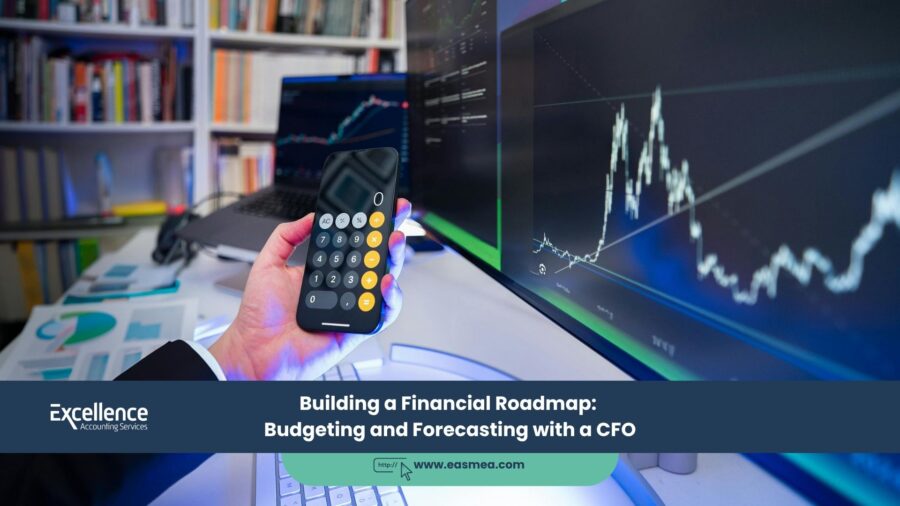Building a Financial Roadmap: Budgeting and Forecasting with a CFO
Every successful journey begins with a map. For a business in the competitive landscape of the UAE, that map is built with two essential tools: a budget and a forecast. While often used interchangeably, these two financial disciplines serve distinct but complementary purposes. A budget sets the destination—the financial goals and spending limits for the year. A forecast is the GPS—a dynamic, real-time tool that tracks your progress, anticipates roadblocks, and helps you adjust your route to stay on course.
- Building a Financial Roadmap: Budgeting and Forecasting with a CFO
- Budgeting vs. Forecasting: Understanding the Difference
- The CFO-Led Process: Building Your Financial Roadmap
- Build Your Roadmap to Success with an EAS Fractional CFO
- Frequently Asked Questions (FAQs)
- Ready to Build Your Financial Roadmap?
For many CEOs and founders, creating these tools can feel like a chore—a rigid exercise in spreadsheets that quickly becomes outdated. But when wielded by a strategic Chief Financial Officer (CFO), budgeting and forecasting are transformed from static reports into a dynamic financial roadmap. This roadmap becomes the central nervous system of the business, aligning the entire organization, driving accountability, and empowering the CEO to make proactive, data-driven decisions.
This guide will explore the critical roles of budgeting and forecasting in strategic financial management. We will clarify the difference between the two, outline the process a CFO leads to build a powerful financial roadmap, and explain how this process frees the CEO from financial minutiae to focus on leadership and growth. Understanding this framework is the first step to moving your business from reactive problem-solving to proactive strategic execution.
Key Takeaways
- Budget vs. Forecast: A budget is a static annual plan used for control. A forecast is a dynamic, rolling estimate of future performance used for decision-making.
- A CFO’s Role is Strategic: A strategic CFO leads a collaborative process to create a budget that aligns with the company’s vision and a forecast that provides actionable insights.
- The Process is Key: A robust process involves setting strategic goals, building a detailed financial model, conducting variance analysis, and continuously re-forecasting.
- Variance Analysis Drives Accountability: Regularly comparing actual results to the budget and forecast (variance analysis) is crucial for understanding performance and holding teams accountable.
- Beyond Finance: The financial roadmap is a communication tool that aligns sales, marketing, and operations with the company’s financial goals.
- Expertise is Accessible: Fractional CFO services provide SMEs with the high-level expertise needed to build and manage a sophisticated financial roadmap.
Budgeting vs. Forecasting: Understanding the Difference
To appreciate their combined power, you must first understand their individual roles. They are two sides of the same coin: financial planning and analysis (FP&A).
The Budget: Your Annual Plan
A budget is a detailed, quantitative plan of what a business wants to achieve over a specific period, typically one year. It’s a statement of intent.
- Purpose: To set targets, allocate resources, and control spending.
- Time Horizon: Fixed, usually for one fiscal year.
- Nature: Static. It is typically set once a year and is not changed.
- Primary Use: To measure performance against a fixed target. “Did we hit our budget?”
The Forecast: Your Dynamic Outlook
A forecast is an estimate of a company’s future financial performance based on historical data, current trends, and known future events. It’s a statement of expectation.
- Purpose: To predict future outcomes, manage cash flow, and support agile decision-making.
- Time Horizon: Rolling, often updated monthly or quarterly to look ahead for the next 12-18 months.
- Nature: Dynamic. It is constantly updated with actual results and new information.
- Primary Use: To anticipate future needs and opportunities. “Based on our current trajectory, where will we end the year?”
| Attribute | Budget | Forecast |
|---|---|---|
| Purpose | Planning & Control | Prediction & Decision-Making |
| Timeframe | Fixed (e.g., 1 year) | Rolling (e.g., next 12 months) |
| Frequency | Created annually | Updated monthly or quarterly |
| Nature | Static Target | Dynamic Estimate |
| Core Question | “What do we want to achieve?” | “What do we expect to achieve?” |
The CFO-Led Process: Building Your Financial Roadmap
A strategic CFO doesn’t just create these documents in isolation. They lead a collaborative process that integrates them into the fabric of the business.
Step 1: Strategic Goal Setting (with the CEO)
The process begins with the CEO’s vision. The CEO sets the strategic direction: “We want to grow revenue by 40% and launch in a new market.” The CFO’s role is to translate this vision into quantifiable financial goals that will form the foundation of the budget.
Step 2: Building the Financial Model and Budget
The CFO and their team build a detailed, assumption-driven financial model. This is a bottom-up process involving input from all department heads (sales, marketing, operations) to ensure the budget is realistic and has company-wide buy-in. The final budget will detail expected revenues, costs, profits, and cash flows for the year ahead.
Step 3: Execution and Monthly Reporting
Once the year begins, the finance team, under the CFO, provides timely and accurate monthly financial reports. This is where the budget is used for control.
Step 4: Variance Analysis
This is a critical monthly meeting led by the CFO. The team compares the actual results for the month against the budget. The goal is not to assign blame, but to understand *why* the variances occurred. “Why were sales 10% below budget? Why were marketing costs 15% over budget?” This analysis provides crucial insights into the business’s performance.
Step 5: Re-Forecasting
Using the insights from the variance analysis, the CFO updates the financial forecast. If sales are trending higher than expected, the forecast is adjusted upwards. If a new, unexpected cost has arisen, it is built into the forecast. This updated forecast gives the CEO the most accurate, up-to-date picture of where the company is heading, allowing for agile adjustments to strategy.
This continuous loop—Plan (Budget), Measure (Actuals), Analyze (Variance), and Adjust (Forecast)—is the essence of strategic financial management. It transforms finance from a historical reporting function into a forward-looking strategic partner.
Build Your Roadmap to Success with an EAS Fractional CFO
Implementing a sophisticated budgeting and forecasting process requires expertise that many SMEs don’t have in-house. Excellence Accounting Services (EAS) provides this expertise through our Fractional CFO services.
Our Financial Planning & Analysis (FP&A) Services:
- Strategic Budgeting: We lead a collaborative process to build a comprehensive annual budget that is aligned with your strategic vision.
- Dynamic Financial Forecasting: We develop and maintain a rolling financial model and forecast, providing you with a clear view of your financial future.
- Variance Analysis and Reporting: We provide insightful monthly reports that explain not just what happened, but why it happened, and what it means for your business.
- CEO Advisory: We act as your strategic partner, using the financial roadmap to provide data-driven advice on key business decisions.
Frequently Asked Questions (FAQs)
Yes. Even for a small business, they serve different needs. The budget provides a disciplined plan and spending limits. The forecast provides an early warning system. For example, your forecast might show you are on track to run out of cash in six months, giving you time to secure a loan, even if you are currently hitting your budget.
A P&L forecast predicts your profitability. A cash flow forecast predicts your actual cash balance. They can be very different. For example, you might make a large profitable sale (good for the P&L), but if the customer doesn’t pay you for 90 days, your cash position won’t improve. The cash flow forecast is essential for managing liquidity.
A rolling forecast is a forecast that is continuously updated. For example, at the end of each month, you add a new month to the end of the forecast period. This means you always have a 12-month forward-looking view, which is much more useful for planning than a static annual forecast that gets shorter as the year progresses.
The process should be led by the CFO, but it must involve the heads of all major departments (Sales, Marketing, Operations, HR). This “participative budgeting” ensures that the targets are realistic and creates a sense of ownership and accountability across the organization.
Not necessarily. It’s rare for actuals to perfectly match the budget. The purpose of the budget is to be a benchmark. The important thing is to understand the *variances*. A large, unexplained variance could signal a problem, but a variance that is understood and explained is simply a learning opportunity.
Zero-based budgeting is a method where every department’s budget starts from zero each year. Managers must justify every single expense, rather than just taking last year’s budget and adding a percentage. It can be a powerful tool for controlling costs but is more time-consuming than traditional budgeting.
A company’s business valuation is heavily based on its future earning potential. A well-constructed, assumption-driven forecast, with a history of accurately predicting performance, gives investors and buyers immense confidence in your ability to deliver on your future promises, which can lead to a higher valuation.
Yes. Zoho Books has a budgeting feature that allows you to set a budget and then run “Budget vs. Actuals” reports automatically. This simplifies the variance analysis process. For more sophisticated forecasting and modeling, the data from Zoho Books is typically exported to a dedicated financial modeling tool or a well-structured spreadsheet.
A “top-down” budget is where senior management sets high-level targets, and departments must create a budget to fit them. A “bottom-up” budget is where each department creates its own budget, which is then rolled up to create the company-wide budget. The most effective process is usually a combination of both.
The budget sets clear, measurable targets for each department. The monthly variance analysis then measures their performance against those targets. This creates a culture of accountability where department heads are responsible for their financial performance and must be able to explain their results.
Conclusion: From Guesswork to Guided Strategy
Running a business without a financial roadmap is like navigating a ship at night without a compass or a GPS. You might be moving, but you don’t know if you’re heading in the right direction. By embracing the disciplined process of budgeting and forecasting, and by partnering with a strategic CFO to lead it, you replace guesswork with guided strategy. You gain the clarity to see what’s ahead, the agility to adapt to change, and the freedom to focus on what you do best: leading your business to its destination.
Ready to Build Your Financial Roadmap?
Our Fractional CFO services provide the expertise to build and manage a dynamic financial roadmap that will guide your business to sustainable growth.




